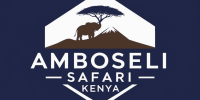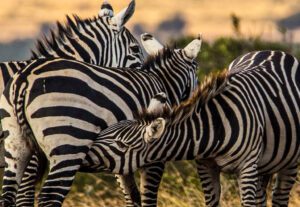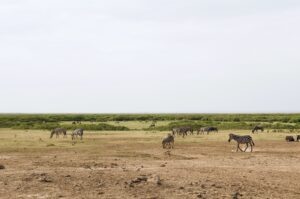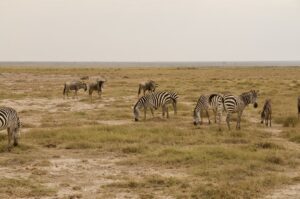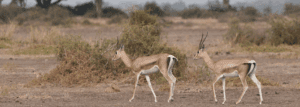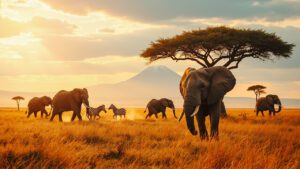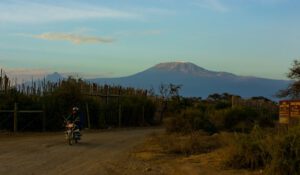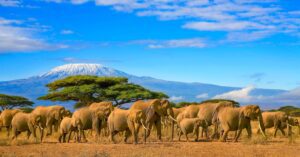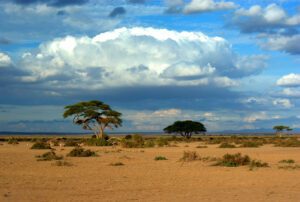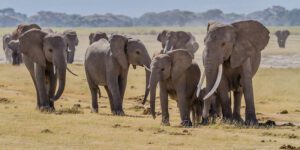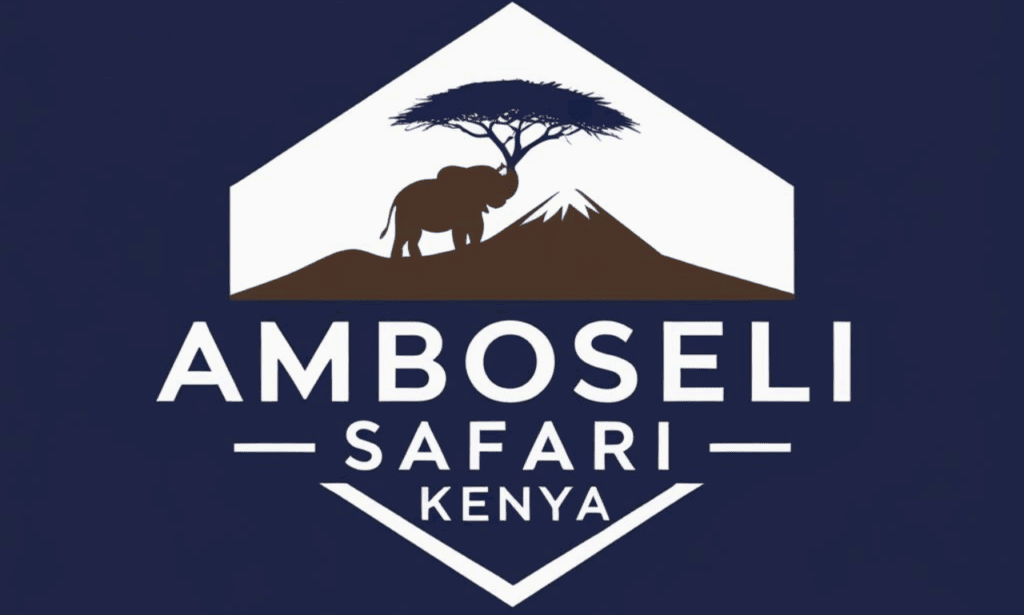What is included in the 3 Days Amboseli Safari Package?
The 3 Days Amboseli Safari Package typically includes a range of services and experiences to ensure travelers have an enjoyable and comfortable visit to Amboseli National Park. First, most national park safari packages include guided game drives in a four-wheel-drive safari vehicle with a pop-up roof, which allows for excellent wildlife viewing and photography. These game drives are led by experienced guides who know the area and can help you spot the park’s famous wildlife, such as the majestic elephants, giraffes, lions, zebras, and more.
Accommodations for two nights are also a key part of the package. Depending on the specific package you choose, you may stay in a luxury lodge, permanent tented camp, or budget-friendly accommodation within or near the park. The packages usually include full-board meals (breakfast, lunch, and dinner) tailored to keep you energized during your Amboseli adventure.
Additionally, all park entry fees and conservation fees are typically included in the package. If you’re being picked up from a starting point like Nairobi or another major city, transportation to and from Amboseli is usually part of the deal. This may include pick-up and drop-off at your hotel or at the airport, making your safari journey seamless.
Some packages also offer add-ons, such as cultural visits to a local Maasai village, where you can learn about the lives and traditions of this indigenous Kenyan community. Drinking water is often included as well, but other beverages like sodas or alcoholic drinks may not be covered.
It’s always good to confirm the details with the safari operator, as every package might vary slightly. In summary: guided game drives, accommodations, meals, transport, park fees, and sometimes cultural visits are all part of what makes up the 3 Days Amboseli Safari Package, ensuring a memorable safari experience.
What are the main attractions in Amboseli National Park?
Amboseli National Park is one of Kenya’s most famous parks, offering stunning and diverse attractions that draw visitors from all over the world. Perhaps the most iconic feature of the park is its magnificent views of Mount Kilimanjaro, which happens to be the tallest mountain in Africa. Even though the mountain is located in neighboring Tanzania, its snow-capped peak creates a breathtaking backdrop for photographs, especially during sunrise and sunset over the Amboseli plains, making it a perfect safari destination.
Another major attraction is Amboseli’s renowned population of free-ranging elephants. The park is often called the “Land of Giants” because of its large herds of elephants walking across the open savannah. These majestic wildlife sightings provide unforgettable safari moments, particularly during the national park safari experiences that allow for close encounters.
The park is also home to a diverse array of wildlife and bird species. Visitors can see lions, cheetahs, zebras, giraffes, buffalo, hippos, hyenas, and more during their safari journey. Bird enthusiasts will love spotting some of the 400 bird species that inhabit Amboseli, including flamingos and herons, adding to the rich biodiversity of the area.
Amboseli’s beautiful and dramatic landscapes are themselves a huge attraction. Vast stretches of open savannah, marshlands, and dry lake beds provide contrasting environments that make the park unique. The seasonal swamps fed by underground streams from Mount Kilimanjaro are an oasis for wildlife, especially during the dry season, enhancing the overall experience of a road safari.
Lastly, cultural experiences are an attraction in their own right. Many safari packages include visits to local Maasai villages, where visitors can learn about the cultural traditions, music, and dances of one of Kenya’s most famous communities.
In short, the park’s attractions combine iconic scenery (Mount Kilimanjaro), abundant wildlife, unique habitats, and cultural richness, making it one of the top destinations for a memorable safari experience in Africa.
What types of wildlife can be expected during the safari?
During a safari in Amboseli National Park, you can expect to encounter a wide variety of wildlife, not only in terms of species but also in terms of unique safari experiences. Perhaps the most famous and frequently spotted residents of Amboseli are its herds of big elephant herds. In fact, the park is renowned for having one of the most studied and protected populations of elephants in the world, with large families often seen near the swamps or crossing the plains. This makes Amboseli a top iconic wildlife destination for those interested in African wildlife.
In addition to elephants, Amboseli is home to big cats such as lions and cheetahs, which can be spotted hunting or lounging in the shade. Leopards, while present, are more elusive and harder to spot compared to other animals. Carnivores like hyenas and jackals are also part of the ecosystem and can be seen scavenging or socializing in groups, contributing to the diverse wildlife experience.
Ungulates (hoofed animals) are abundant in Amboseli. You’ll likely see zebras, wildebeests, giraffes, buffalo, and antelopes like Thomson’s gazelles or impalas grazing the grasslands. Hippos are typically found near or in water-rich areas like the seasonal swamps, making this park a fantastic location for a memorable safari experience.
Bird enthusiasts will find the park particularly exciting because Amboseli is home to over 400 bird species. Some common sightings include flamingos in the wet seasons (along the lakebeds), long-crested eagles, herons, and secretary birds. Birds of prey like vultures and hawks are often seen perched or circling overhead, enhancing the park’s rich biodiversity.
The park’s seasonal environment might determine what wildlife you see and in what quantity, for example, during the dry season, animals often gather around wet swamp areas, providing excellent viewing opportunities. Whether you’re after the celebrated “Big Five” (lion, elephant, buffalo, leopard, and rhino – though rhinos are rare here) or simply fascinated by the dynamics of the animal kingdom, Amboseli delivers a rich wildlife experience that is truly unforgettable.
What is the itinerary for the 3 days?
The itinerary for a 3-day Amboseli Safari Package generally lays out a schedule that ensures you maximize your time in Amboseli National Park, exploring its beauty and wildlife. Here’s a typical example of what you can expect each day:
Day 1: The trip often begins in the morning, with either a pick-up from a hotel in Nairobi or a central meeting point. After a brief introduction to the itinerary, you head out to Amboseli National Park, which is usually about a 4 to 5-hour drive. Along the way, you’ll get a chance to see the bustling Kenyan countryside and maybe make a short stop at intriguing roadside viewpoints.
Once you arrive at Amboseli, you check in to your accommodation, which could be safari lodges or campsites, depending on the package. After lunch and a brief rest, you’ll go on your first game drive. During this afternoon game drive, you’ll explore the park and begin spotting wildlife. Amboseli is famous for its large elephant herds and breathtaking views of Mount Kilimanjaro, which might form the perfect backdrop for your wildlife photographs. The day concludes with dinner, served at your lodge, and some downtime to relax.
Day 2: Day 2 usually starts early because morning game drives are the best time to see animals when they’re most active. You’ll set out at dawn, looking for iconic creatures like lions, cheetahs, and giraffes. After a few hours of roaming the park, you’ll return to your lodge for breakfast. The middle part of the day is often reserved for some relaxation to avoid the intense afternoon heat. You can rest in your lodging or explore nearby cultural activities, such as visiting a Maasai village, depending on your package.
In the late afternoon, another game drive is scheduled. This offers a chance to revisit your favorite spots or explore new areas of the park. Once done, you’ll enjoy dinner back at your lodge and get some rest after an exciting day.
Day 3: The third day usually starts with one final early morning game drive for any last glimpses of the wildlife and stunning landscapes. After breakfast at your lodge, you’ll check out and begin the journey back to Nairobi. Depending on your specific package, there might be stops for souvenirs or scenic viewpoints on the return.
This itinerary is designed to balance exciting wildlife experiences, cultural exposure, and a bit of relaxation. Exact schedules can vary depending on who organizes the safari, but the above framework gives a good idea of what a 3-day Amboseli adventure entails, showcasing the remarkable wildlife and breathtaking landscapes of the region.
Are accommodations included in the package, and what type of lodging is provided?
Yes, accommodations are typically included in a 3-day Amboseli National Park safari package. The type of lodging provided will depend on the package you choose since safaris are tailored to a range of budgets and preferences. There are generally two main options: luxury lodges/camps and budget-friendly options. Here’s what to expect in both categories:
Luxury Lodging: In the premium tier, safari packages often include stays at high-end lodges or tented camps that boast all the comforts of a modern hotel. These lodges usually have spacious rooms or luxurious tents equipped with comfortable beds, en-suite bathrooms, and hot showers. Some lodges even offer swimming pools, outdoor dining setups, and personal service to let you unwind after a long day of game drives. For example, you might stay in places like Tortilis Camp, which has amazing views of Mount Kilimanjaro and gourmet meals.
Midrange or Budget Options: For travelers looking for a cost-effective but pleasant experience, accommodations might include smaller lodges or basic campsites just outside or within the park. These budget options are functional and safe, offering comfortable bedding and essential amenities like mosquito nets, shared bathrooms, and decent meals. A common option in this category could be places like Kibo Safari Camp, which provides an affordable yet cozy safari experience.
Regardless of the tier you select, all accommodations included in the package are usually located near Amboseli National Park or within the conservancies around it. The goal is to ensure your stays are conveniently close to the varied habitats and wildlife action.
When booking your package, it’s important to clarify the type of lodging you’ll be provided, as this can significantly affect your memorable safari experience and overall cost. Many safari operators allow you to customize the accommodation component to match your travel preferences and budget.
What is the cost of the safari package, and are there any additional expenses?
The cost of a 3-day Amboseli Safari Package can vary widely based on factors like the type of accommodations, transportation, and additional services included. Here’s a general breakdown to give you a sense of what you might expect:
Budget Range: For a budget-friendly safari, prices can start from approximately $400 to $600 per person. This typically includes shared or basic accommodations, transportation in a basic safari vehicle, daily meals, and park entrance fees.
Midrange to Luxury Range: If you’re looking for a more comfortable or luxurious experience, you could expect to pay between $800 and $1,500 per person. This price tier often covers lush accommodations like private lodges or luxury tented camps, high-quality safari vehicles, and possibly additional perks like guided cultural tours or sundowner experiences.
Additional Expenses to Consider: While many things are included in the standard package price, there are often a few extra costs that you should budget for:
- Drinks and Special Dining: While meals are usually included, extra beverages (especially alcoholic drinks) may not be. Some lodges may charge for bottled water, soft drinks, and wine.
- Tips: It’s common to tip your safari guide, driver, and lodging staff as a gesture of appreciation. The recommended tipping amount is about $10-$20 per day for guides and $5-$10 per day for hotel staff.
- Souvenirs: If you stop at a Maasai village or local markets, you might want cash to purchase handmade jewelry, carvings, or traditional artworks.
- Travel Insurance: It’s always wise to secure travel insurance for emergencies, which is not typically included in the safari package.
- International Flights: The cost of getting to Kenya (and back home) is not part of most safari packages.
- Visa Fees: You’ll need a visa to enter Kenya, which is an additional cost (usually around $50 for many nationalities).
Being aware of all inclusions and exclusions will ensure that you’re prepared and have no surprises during your safari adventure. Make sure to ask your safari operator for a detailed breakdown of costs to plan accordingly.
Is transportation provided, and what kind of vehicles are used for the safari?
Yes, transportation is typically provided in the 3 Days Amboseli Safari Package. When you’re on an African safari like this, it’s common for the package to include transportation from the start to the end. For instance, you might be picked up from a central location, like a specific hotel or airport in Nairobi, Kenya, and then driven to Amboseli National Park. The journey itself can take a few hours, depending on the starting point, so having comfortable and reliable transportation is crucial for a memorable safari experience.
The most common vehicles used for safaris are specially-designed 4×4 safari jeeps or safari vans. These vehicles are ideal for navigating the rough terrain, dirt paths, and sometimes muddy trails found in Amboseli NP and other game parks. Designed to enhance the safari experience, many have pop-up roofs that allow you to stand and get a better view of the diverse wildlife while staying safe inside the vehicle. They are raised higher than regular cars, making it easier to spot majestic wildlife, including the big elephant herds that are a highlight of the park.
For example, let’s say you’re on a game drive and the vehicle stops near a herd of elephants. By being in a safari jeep with a pop-up roof, you’ll be able to observe them clearly and even take incredible safari photographs without ever stepping out of the car. These vehicles are also equipped with large windows for maximum visibility and are usually comfortable enough for long drives. Additionally, drivers are often well-trained to handle wildlife encounters, ensuring a safe journey. So, rest assured, transportation during your safari will not only be provided but also well-suited for the adventure in the breathtaking landscapes of Amboseli National Park!
What should I pack for the 3-day safari?
Packing for a safari might seem tricky, especially when planning a memorable safari experience in renowned Amboseli National Park, but it’s easier than you think if you know what to prioritize. The goal is to be prepared for various situations, including warm days, cool mornings and evenings, and exposure to nature. Here’s a breakdown of the essentials.
First, pack comfortable, lightweight clothing. Neutral colors like beige, khaki, or olive are best because they blend in better with the natural environment (bright colors might distract animals). You’ll need long-sleeved shirts and trousers for protection from the sun and insects, especially during early morning or evening drives when mosquitos are more active. A hat and sunglasses are also essentials to shield yourself from the sun.
Second, bring sturdy, comfortable shoes. While you’ll mostly stay in the safari vehicle during your Amboseli adventure, there may be rare moments when you step outside or need to walk short distances. Sneakers or light hiking boots work well for these occasions.
Don’t forget personal essentials, such as sunscreen, insect repellent, and lip balm with SPF. Pack a small first aid kit with basics like band-aids and pain relievers, just in case. Binoculars are a must, as they’ll help you spot the majestic wildlife from afar. And of course, pack your camera or smartphone to capture amazing wildlife moments. Pro tip: Bring extra batteries or a portable charger.
Finally, include layers for the cooler mornings and evenings. A light jacket or fleece will keep you warm, but make sure it’s easy to remove as the day heats up. Don’t forget a reusable water bottle to stay hydrated throughout the day.
So, remember: think practical, lightweight, and weather-appropriate. Safaris are all about being comfortable and prepared for the breathtaking landscapes you will encounter!
Are meals and drinks included during the safari?
Yes, meals and basic drinks are usually included in the 3 Days Amboseli Safari Package. When you book a safari like this, most packages are designed to cover your basic needs, so food and hydration are part of the experience.
Typically, you’ll have three meals provided per day: breakfast, lunch, and dinner. For example, you might start your day with a hearty breakfast at your lodge or camp to energize you before heading out on a morning game drive. Lunch might be served as a picnic out in the park, especially if you’re exploring far from your lodging during the day. Then, dinner is usually enjoyed back at the lodge or camp, where you can relax after a long day of adventure. Meals often feature a mix of local and international dishes, so you may get to try Kenyan delicacies like nyama choma (grilled meat) or ugali while also enjoying familiar options.
Basic drinks like tea, coffee, and water are generally included, but alcohol and some specialty beverages may come at an extra cost. For example, if you want a glass of wine or a bottle of beer with your dinner, that would likely not be covered under the package price.
In some cases, meals are buffet-style, which gives you plenty of options to choose from, while others might be plated. If you have dietary restrictions, most safari organizers can accommodate them if you inform them in advance.
To sum up, you don’t need to worry about going hungry or being thirsty! Meals and basic refreshments are taken care of so you can focus on enjoying the wildlife and beautiful scenery.
Are guided tours or professional guides included in the package?
Yes, guided tours or professional guides are typically included in a 3-day Amboseli National Park safari package. These guides are local experts who know the park like the back of their hand. Their role is to make your experience as enjoyable, educational, and safe as possible, especially when exploring the diverse wildlife that thrives in this area. They have extensive knowledge of the wildlife, landscapes, and culture of the region, which enhances your safari experience significantly.
For example, if you see a lion in the distance, the guide will explain its behavior, habitat, and even how it interacts with other animals in the ecosystem. They also help identify the hundreds of bird species in the park (like flamingos or African fish eagles) and recognize subtle signs of animal activity that most tourists would miss entirely, making your national park safari even more enriching.
These guides are often skilled at tracking animals, which increases your chances of spotting iconic species like elephants, cheetahs, and giraffes during the safari. They’re also trained in safety protocols to ensure your well-being while being near wild animals. If you’re worried about language barriers, most professional guides speak English fluently, and some speak other languages based on popular demand.
Having a guide also makes the safari stress-free. On the bumpy rides through the park, they share fascinating stories about Amboseli National Park’s Masai culture, geography, and conservation efforts that you might not learn from Googling alone. Plus, they know the best spots for photographing Mount Kilimanjaro in the background, a once-in-a-lifetime view!
So bottom line: when you book an Amboseli safari package, the cost typically includes guided tours with professional experts who ensure you get the most out of your adventure.
What is the best time of year to book this safari package?
The best time to visit Amboseli National Park is during its dry seasons, which run from June to October and January to February. During these times, the weather is more predictable, and animals are easier to spot as they gather around water sources while other regions dry up. The vegetation is also less dense, making wildlife sightings much clearer, especially during a national park safari.
For example, during the dry season, you’re more likely to see large elephant herds moving through the park’s open plains. Amboseli is globally known for its African wildlife, particularly its elephants, often seen bathing or walking against the breathtaking backdrop of the majestic Mount Kilimanjaro. Predators like lions and cheetahs are also easier to spot as they often wait around waterholes for prey.
The rainy seasons, which occur in November to December (short rains) and March to May (long rains), do have their own charm but pose challenges. These months bring lush vegetation and fewer tourists, creating a peaceful environment, but it also means some roads in the park become muddy or inaccessible. Animals tend to disperse, making them harder to find during an Amboseli adventure.
If you’re a photography enthusiast, clear skies during the dry seasons provide stunning views of Kilimanjaro in the early morning or evening. However, if lush greenery and birds are your thing, visiting after the rains might suit your travel preferences better since migratory bird species arrive.
Keep in mind that the park can get busy in the dry season, so booking in advance is a must if you want the best accommodations and guides. In contrast, the greener wet season might offer discounts due to fewer visitors. Overall, June to October offers the most consistent conditions for memorable wildlife viewing and a comfortable safari experience.
Are there any specific rules or tips for visiting Amboseli National Park?
Yes, there are specific rules and tips you should follow to ensure you have a safe, enjoyable, and responsible visit to Amboseli National Park, a renowned safari destination known for its majestic wildlife and breathtaking landscapes. Following these guidelines will also help protect the park’s delicate ecosystem and diverse wildlife.
Rules:
- Respect Wildlife: Maintain a safe distance from all animals. Do not attempt to feed, touch, or provoke them. This keeps both you and the animals safe.
- Stick to Tracks: Visitors are required to stick to designated roads and trails. Off-road driving can damage vegetation and disturb animals.
- Littering is Prohibited: Dispose of all waste responsibly. Littering harms the natural environment and wildlife.
- Noise Control: Keep noise to a minimum. Loud noises can scare the animals and disrupt the serene environment.
- No Flash Photography: When taking pictures, avoid using the flash, as it can startle or stress animals.
- Do Not Pick Plants: Removing vegetation or any natural objects from the park is strictly forbidden.
- Follow Guide Instructions: Always listen to and follow your guide’s advice to ensure your safety and that of the group.
Tips:
- Early Morning Game Drives Are Best: Animals are more active in the early morning or late afternoon when temperatures are cooler. Make sure you’re up early to catch the best opportunities for sightings.
- Pack the Right Gear: Bring binoculars, sunscreen, a hat, comfortable walking shoes, and safari-friendly clothing (neutral colors like khaki or tan work best).
- Bring a Camera: Amboseli is famous for its beautiful landscapes and wildlife, so having a decent camera is a must for capturing memories.
- Be Patient: Wildlife isn’t on a schedule, so take your time. Guides are experts at tracking, but patience often leads to the best sightings.
- Support Local Communities: Consider buying souvenirs directly from the local Masai people to contribute to their livelihood.
- Carry Cash for Tips: It’s customary to tip your guide or driver at the end of the trip, especially if they provide excellent service.
By adhering to these rules and tips, you’ll not only have a rewarding Amboseli adventure but also help keep Amboseli National Park pristine for future generations!
